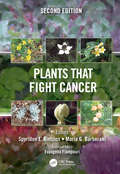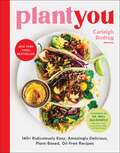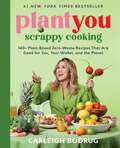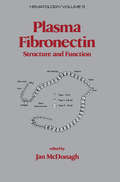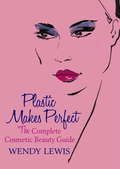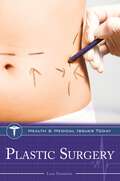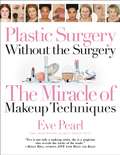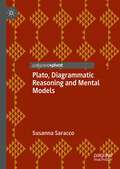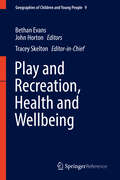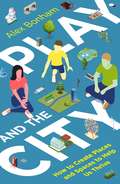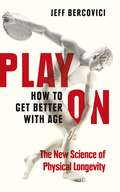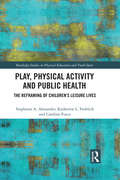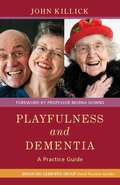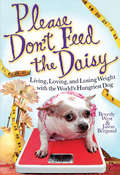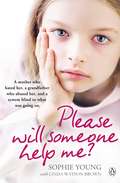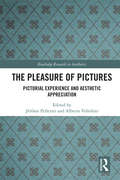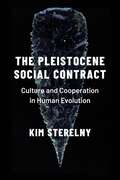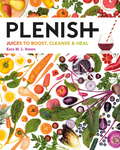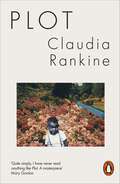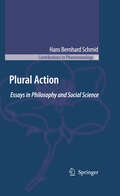- Table View
- List View
Plants that Fight Cancer, Second Edition
by Spyridon E. Kintzios Maria G. BarberakiAn increasing amount of cancer research is being directed towards the investigation of plant-derived anticancer compounds, many of which have been used in traditional herbal treatments for centuries. Plants that Fight Cancer is an up-to-date, extensive review of plant genera and species with documented anti-tumor and anti-leukaemic properties. Following an overview of the disease and the diverse methods of therapy and clinical testing, the book provides a detailed examination of the plants whose compounds are currently used in conventional cancer treatment, the species which show the greatest potential as future candidates, and other species with established anticancer properties. The third section explores each of more than 150 terrestrial plant genera and species, with a review of their traditional uses, mythology, botany, active ingredients, and product applications, along with photographs and illustrations and an analysis of expected results and risks. The text closes with a discussion of algal extracts and isolated metabolites with anticancer activity, a summary of published research for each species, and chemical structures of the most important compounds.
Plants that Fight Cancer, Second Edition
by Spyridon E. Kintzios Maria G. Barberaki Evangelia A. FlampouriAn increasing amount of cancer research is being directed towards the investigation of plant-derived anticancer compounds, many of which have been used in traditional herbal treatments for centuries. Plants that Fight Cancer is an up-to-date, extensive review of plant genera and species with documented anti-tumor and anti-leukaemic properties. Following an overview of the disease and the diverse methods of therapy and clinical testing, the book provides a detailed examination of the plants whose compounds are currently used in conventional cancer treatment, the species which show the greatest potential as future candidates, and other species with established anticancer properties. The third section explores each of more than 150 terrestrial plant genera and species, with a review of their traditional uses, mythology, botany, active ingredients, and product applications, along with photographs and illustrations and an analysis of expected results and risks. The text closes with a discussion of algal extracts and isolated metabolites with anticancer activity, a summary of published research for each species, and chemical structures of the most important compounds.
PlantYou: 140+ Ridiculously Easy, Amazingly Delicious Plant-Based Oil-Free Recipes
by Carleigh BodrugINSTANT NEW YORK TIMES BESTSELLERPlant-based eating doesn't have to be complicated! The delicious recipes in this easy-to-follow cookbook are guaranteed to keep you inspired and motivated.Enter PlantYou, the ridiculously easy plant-based, oil-free cookbook with over 140+ healthy vegan recipes for breakfast, lunch, dinner, cheese sauces, salad dressings, dessert and more!In her eagerly anticipated debut cookbook, Carleigh Bodrug, the Founder of the wildly popular social media community PlantYou, provides readers with the ultimate full color guidebook that makes plant-based meal planning, grocery shopping and cooking a breeze. With every single recipe, you will find a visual infographic marking the ingredients you need, making it easy to shop, determine portion sizes, and dive into the delicious and nutritious dishes.Get ready for mouthwatering dishes like Chocolate Chip Banana Bread Breakfast Cookies, Best Ever Cauli Wings, and the Big BOSS Burrito that you simply won&’t believe are made from plants. &“An instant kitchen classic…In your quest to find delicious food that also promotes health, both human health and the health of the planet and the animals we share our world with, you&’ve come to the right place.&” —from the foreword by Dr. Will Bulsiewicz
PlantYou: 140+ Plant-Based Zero-Waste Recipes That Are Good for You, Your Wallet, and the Planet
by Carleigh BodrugInstant #1 New York Times BestsellerSave money, reduce food waste, and eat healthier than you ever have before with this highly anticipated cookbook from New York Times bestselling author and social media sensation, Carleigh Bodrug. Spinning off of Bodrug's wildly popular Scrappy Cooking social media series, the cookbook is packed with over 150+ whole-food, plant-based recipes that show the reader how to make the most of the food they have in their fridge and pantry with easy and approachable vegan recipes anyone can make. Transform radish tops into pesto, broccoli stems into summer rolls and wilting greens into smoothie cubes... But that's not all. The book will equip readers with not only the tools to make the most of their scraps, but use up just about any vegetable, grain or bean from their fridge and pantry in the flexible Kitchen Raid Recipes, or cross reference commonly wasted foods like stale bread from a "Got This, Make That" index so these items can be used up in the easiest and most delicious way possible. Scrappy Cooking not only puts the focus on eating a diet that's more conscious for our environment (and our wallets) but our health as well. Every recipe in the book is vegan, almost entirely oil free, and focuses on whole, plant-based foods that are good for our bodies and the planet. Get ready for recipes like The Whole Darn Squash (Pasta), Skillet Lasagna, One Pan Orzo Casserole, Vodka Penne With Broccolini, Whole Roasted Cauliflower with Roasted Red Pepper Sauce, Chickpea Pot Pie, Orange Peel Chickn&’, Loaded Tortilla Bowls, Sheet Pan Tacos with Carrot Top Chimichurri, Rebel &“Ribs&”, Veggie Masala Burgers, Palak &“Paneer&”, Vegan Meaty Hand Pies, We-Got-the-Beet Chips, Pickle-Mania Chips, Cornmeal Biscuits, Bang Bang Broccoli-cious Steaks…and more!
Plasma Fibronectin: Structure and Functions
by Jan McdonaghThis volume deals with a multifunctional plasma and tissue protein, fibronectin, which participates in many significant biological and pathophysiological actions, presenting the information concerning structure and describing the interactions of fibronectin with fibrinogen and fibrin.
Plasma Fibronectin: Structure and Functions
by Jan McdonaghThis volume deals with a multifunctional plasma and tissue protein, fibronectin, which participates in many significant biological and pathophysiological actions, presenting the information concerning structure and describing the interactions of fibronectin with fibrinogen and fibrin.
Plastic Makes Perfect: The Complete Cosmetic Beauty Guide
by Wendy LewisThe must-have guide to cosmetic surgery written by the world's leading independent consultant.Cosmetic surgery, once the preserve of the jet-setting rich, is now something more people than ever are prepared to consider, and the industry is worth almost £700 million in the UK alone. But what is involved, what are the risks and how much does it cost?This comprehensive guide by one of the world's leading experts outlines all the latest surgical procedures and non-invasive treatments and gives the facts you need to make an informed decision on whether it is right for you. Giving the reader the low down on the most popular cosmetic surgical procedures and the non-surgical alternatives, Wendy provides details on the very latest techniques and procedures, the questions to ask, the resources to help you find the best doctors, hints on speeding post-op recovery and the ways to negotiate potential pitfalls.Deciding to have a cosmetic procedure is a very personal journey to embark on. PLASTIC MAKES PERFECT is filled with expert but friendly advice on one of the most important life-altering decisions we can make.
Plastic Surgery (Health and Medical Issues Today)
by Lana ThompsonThis book provides a complete history of plastic surgery, a description of the modern techniques and choices available, and an overview of the controversies surrounding the choice to voluntarily change your physical appearance.Plastic surgery was historically considered a medical necessity. These were procedures specifically developed to treat burn or accident victims, to correct those born with cleft palates, or to repair extreme cases of cosmetic disfigurement, such as amputations performed as a punishment for adulterous men. Today, however, plastic surgery is a common option for those seeking to modify their normal and uninjured bodies to conform to an unrealistic, idealized model of perfection.This book presents the fascinating history of how therapeutic techniques were adapted to offer cosmetic changes to patients without disfiguring bodily flaws. The first section of Plastic Surgery details this evolution by tracing the history from development of the medical techniques to the choices currently available today. The second section digs deeper to examine the controversies and issues associated with plastic surgery, such as race, beauty, and gender reassignment. The third section offers primary documents produced by medical authorities regarding accepted procedures and practices, as well as an expansive glossary and timeline.
Plastic Surgery Without the Surgery: The Miracle of Makeup Techniques
by Eve PearlGet the glowing good looks of your dreams without plastic surgery, as revealed by Emmy Award-winning makeup artist Eve Pearl. Have you been contemplating Botox, eyelid surgery, or breast augmentation? A face-lift, nose job, or collagen injections? Save your money and avoid the risks! By applying the same Hollywood-insider methods used to make celebrities look years younger and show-stopping gorgeous, Eve Pearl shows you how to enhance your lips, diminish wrinkles, and even appear to go from an A-cup bra to a generous B or even C! Like a magic wand, makeup-done as you've never seen it before-will accentuate the uniqueness of your looks while disguising the flaws. With Eve Pearl's simple but amazing techniques, you can completely transform your face, eyes, brows, nose, lips, and breasts. And this powerful, safe way to a more youthful and natural beauty takes just minutes to achieve. Discover: The "face-lift" kit that tightens skin, brings out the eyes, and hides deep laugh lines around the nose and mouth Fantastic remedies for dark circles under the eyes, puffiness, and crow's-feet How to use moisturizers and foundations to create velvety, luminous skin tones-without the dangers of a chemical peel or bleaching Dramatic shading to produce elegant cheekbones and make a double chin disappear Techniques to make your breasts look larger (you won't believe your eyes!) Products to create fuller, more sensuous lips with a "sweetheart" shape and a luscious shine . . . and much more. From eye-lift to face-lift, you will be thrilled by the results -- without the pain, risk, or expense of surgery!
Plato, Diagrammatic Reasoning and Mental Models
by Susanna SaraccoThis book analyses the role of diagrammatic reasoning in Plato’s philosophy: the readers will realize that Plato, describing the stages of human cognitive development using a diagram, poses a logic problem to stimulate the general reasoning abilities of his readers. Following the examination of mental models in this book, the readers will reflect on what inferences can be useful to approach this kind of logic problem. Plato calls for a collaboration between writer and readers. In this book the readers will examine the connection between diagrams and discovery, realizing the important epistemic role of visualization. They will recognize the crucial role that diagrams play in problem solving. The logic problem elaborated by Plato is addressed considering the epistemic function of mental models. These models introduce to an advanced stage of cognitive development, in which reasoning uses in its investigations a higher-level of mathematical complexity, represented by structuralism.
Play and the City: How to Create Places and Spaces To Help Us Thrive
by Alex BonhamPlay is essential, for children but also adults. It's how we relax and revitalise ourselves, build and maintain friendships, try new things, learn and innovate.Cities have always been sites of play, bringing people together and pushing the boundaries of what is humanly possible. And now we need our cities to encourage and facilitate play of all kinds more than ever. If we want a world for our children to play in, we need to have a go at doing things differently. A city that is enjoyable to live in - that provides welcoming spaces, plentiful resources, and an attitude of 'yes, you can' - is a playful city. A city that is good for eight-year-olds as well as eighty-year-olds is a city that's good for all of us. By looking at how different cities across space and time have sought to encourage and facilitate play, Bonham shows us how to conceptualise our own contemporary city as a game, and encourages us to become participants rather than spectators.Play the city! Get involved, make a difference and help to bring your city back to life. There is help here to identify opportunities, build a team of friends and allies, take part - and win! It's time to make your move.
Play On: How to Get Better With Age
by Jeff BercoviciHow do the world's best athletes combat ageing, and what you can do to keep up?"Encouraging reading for jocks who are late to the game but committed to the win all the same." Kirkus Review "An energetic romp" that "smartly separates science from quackery." Publishers WeeklySports are about challenging our physical limits. But the greatest limit of all remains undefeated: age. Not, though, for the likes of Roger Federer, Tom Brady and Jo Pavey. What are they doing that you can too?Play On teaches us that it's not aging that causes a decline in fitness; rather, a decline in fitness causes aging.Full of cutting-edge science, technology and practical tips, Play On empowers you to reverse the ageing process, and stay younger for longer.
Play, Physical Activity and Public Health: The Reframing of Children's Leisure Lives (Routledge Studies in Physical Education and Youth Sport)
by Stephanie A. Alexander Katherine L. Frohlich Caroline FuscoAre children playing less than they used to? Are rising obesity rates linked to a decline in children’s time to play freely? These and other related questions have filled the pages of newspapers, magazines and scholarly journals for the past decade. Researchers and journalists have attributed these issues to societal changes around children’s lives and leisure, the growth of structured and organised activities and increasing perceptions of risk in children’s play. Play, Physical Activity and Public Health presents a discussion of the way modern notions of play are rendering children’s leisure activities less free and less engaged in simply for fun. Based on original qualitative research, and analysis of contemporary media from Canada and elsewhere, this book argues that the growing health concerns around childhood play entail a paradox: by advocating, promoting, discussing, and re-directing children’s play, a new form of children’s leisure is emerging - one that is purpose-driven, instrumentalised for health, and ultimately, less free. We explore how play has become goal-oriented, a means to health ends, and how the management of pleasure in play as well as diverse risk discourses around play continue to limit and constrain possibilities for children and families to play and engage in leisure freely. Incorporating past critiques of this trend in play, we argue for research and practice to create new possibilities and ways of thinking about children's play, leisure, fun and childhood, that are less constrained and managed, and importantly less geared towards health goals. This is a valuable resource for students of the sociology of sport, kinesiology, sports and health psychology, education, public health, and childhood studies. It is also an important read for school teachers, public health practitioners, psychologists, physical education teachers, academics and parents interested in how children’s leisure lives are being shaped by the growing and diverse discussions around play.
Play, Physical Activity and Public Health: The Reframing of Children's Leisure Lives (Routledge Studies in Physical Education and Youth Sport)
by Stephanie A. Alexander Katherine L. Frohlich Caroline FuscoAre children playing less than they used to? Are rising obesity rates linked to a decline in children’s time to play freely? These and other related questions have filled the pages of newspapers, magazines and scholarly journals for the past decade. Researchers and journalists have attributed these issues to societal changes around children’s lives and leisure, the growth of structured and organised activities and increasing perceptions of risk in children’s play. Play, Physical Activity and Public Health presents a discussion of the way modern notions of play are rendering children’s leisure activities less free and less engaged in simply for fun. Based on original qualitative research, and analysis of contemporary media from Canada and elsewhere, this book argues that the growing health concerns around childhood play entail a paradox: by advocating, promoting, discussing, and re-directing children’s play, a new form of children’s leisure is emerging - one that is purpose-driven, instrumentalised for health, and ultimately, less free. We explore how play has become goal-oriented, a means to health ends, and how the management of pleasure in play as well as diverse risk discourses around play continue to limit and constrain possibilities for children and families to play and engage in leisure freely. Incorporating past critiques of this trend in play, we argue for research and practice to create new possibilities and ways of thinking about children's play, leisure, fun and childhood, that are less constrained and managed, and importantly less geared towards health goals. This is a valuable resource for students of the sociology of sport, kinesiology, sports and health psychology, education, public health, and childhood studies. It is also an important read for school teachers, public health practitioners, psychologists, physical education teachers, academics and parents interested in how children’s leisure lives are being shaped by the growing and diverse discussions around play.
Playfulness and Dementia: A Practice Guide (PDF)
by Ian Cameron John Killick Kate Allan Nicola Hodge Robin Lang Sarah Zoutewelle-MorrisEstablishing playfulness as an essential component of dementia care, this positive and uplifting book will be key in changing attitudes and providing ideas for new and valuable ways of interacting and being with individuals with the condition. John Killick explores the nature of playfulness and the many ways in which it can enrich the lives of people with dementia, including as a means of maintaining relationships and communication, supporting communication and generally lifting the spirits. Specific approaches already in existence are described, including improvised drama, clowning and laughter yoga, and a chapter on the playful approach to art and craft activities is also included. Personal accounts of playfulness by individuals with dementia, relatives and an actor with a decade's experience of using playful approaches with people with dementia offer rich first-hand insights into its transformative potential. Throughout the book, the importance of spontaneity and of being with the person with dementia in the present moment is emphasised, and the reader is encouraged to develop a playful mindset. A selection of colour photographs amply demonstrate playful approaches in action. Offering a fresh and perhaps unexpected perspective, this book is essential reading for dementia care practitioners and managers, activity coordinators, therapists, people with dementia and their relatives, and anyone else concerned with the wellbeing of those with the condition.
Please Don't Feed the Daisy: Living, Loving, and Losing Weight with the World's Hungriest Dog
by Beverly WestWhen Jason moves in with Bev, it's supposed to be temporary. But then Daisy the Chihuahua comes to stay. Just two-and-a-half pounds when they adopt her, Daisy is a charmer. And soon, an eater. Hot on her heels comes Elvis the pug, and then, of course, their puppies! Instead of losing her baby weight, after giving birth to four puppies, Daisy gets even chubbier and soon outgrows even her fattest fat sweaters. Bev and Jason decide it's time for everyone, including the two of them, to pull together, lead a healthier life-style--and in the process become a family (albeit an unconventional one). Please Don't Feed the Daisy is the wickedly funny, remarkably useful story of their journey toward becoming that family, and a fit one to boot. Packed with yummy, fun, diet- and earth-friendly recipes for both dogs and people, as well as training tips and the Happily Ever After Maintenance Plan, this is a heartwarming and healthy tale for dog- (and food-) lovers everywhere.
Please Will Someone Help Me?
by Sophie YoungSophie Young tells her shocking true story in Please Will Someone Help Me?Sophie Young was born into a dysfunctional family, with a violent mother and father. Sophie was routinely neglected and harmed, starved and left to fend for herself. Social workers were often involved but, despite numerous visits and extensive reports, nothing was ever done.When Sophie was six, her life took another horrible turn: her adored grandfather began to sexually abuse her.Please Will Someone Help Me? is Sophie Young's heartbreaking story about a young girl at the mercy of the adult world. With full access to her social work files, she shows how those who are meant to help children can be blind to the reality of their lives; but how, ultimately, love conquers all.Sophie Young was the eldest of three, born into a dysfunctional family that she fought for years to escape. Now forty years old, she lives in England with her husband and children, and works as a volunteer for a national children's charity.
The Pleasure of Pictures: Pictorial Experience and Aesthetic Appreciation (Routledge Research in Aesthetics)
by Jérôme Pelletier Alberto VoltoliniThe general aim of this volume is to investigate the nature of the relation between pictorial experience and aesthetic appreciation. In particular, it is concerned with the character and intimacy of this relationship: is there a mere causal connection between pictorial experience and aesthetic appreciation, or are the two relata constitutively associated with one another? The essays in the book’s first section investigate important conceptual issues related to the pictorial experience of paintings. In Section II, the essays discuss the notion of styles, techniques, agency, and facture, and also take into account the experience of photographic and cinematic pictures. The Pleasure of Pictures goes substantially beyond current debates in the philosophy of depiction to launch a new area of reflection in philosophical aesthetics.
The Pleasure of Pictures: Pictorial Experience and Aesthetic Appreciation (Routledge Research in Aesthetics)
by Jérôme Pelletier Alberto VoltoliniThe general aim of this volume is to investigate the nature of the relation between pictorial experience and aesthetic appreciation. In particular, it is concerned with the character and intimacy of this relationship: is there a mere causal connection between pictorial experience and aesthetic appreciation, or are the two relata constitutively associated with one another? The essays in the book’s first section investigate important conceptual issues related to the pictorial experience of paintings. In Section II, the essays discuss the notion of styles, techniques, agency, and facture, and also take into account the experience of photographic and cinematic pictures. The Pleasure of Pictures goes substantially beyond current debates in the philosophy of depiction to launch a new area of reflection in philosophical aesthetics.
The Pleistocene Social Contract: Culture and Cooperation in Human Evolution
by Kim SterelnyKim Sterelny here builds on his original account of the evolutionary development and interaction of human culture and cooperation, which he first presented in The Evolved Apprentice (2012). Sterelny sees human evolution not as hinging on a single key innovation, but as emerging from a positive feedback loop caused by smaller divergences from other great apes, including bipedal locomotion, better causal and social reasoning, reproductive cooperation, and changes in diet and foraging style. He advances this argument in The Pleistocene Social Contract with four key claims about cooperation, culture, and their interaction in human evolution. First, he proposes a new model of the evolution of human cooperation. He suggests human cooperation began from a baseline that was probably similar to that of great apes, advancing about 1.8 million years ago to an initial phase of cooperative forging, in small mobile bands. Second, he then presents a novel account of the change in evolutionary dynamics of cooperation: from cooperation profits based on collective action and mutualism, to profits based on direct and indirect reciprocation over the course of the Pleistocene. Third, he addresses the question of normative regulation, or moral norms, for band-scale cooperation, and connects it to the stabilization of indirect reciprocation as a central aspect of forager cooperation. Fourth, he develops an account of the emergence of inequality that links inequality to intermediate levels of conflict and cooperation: a final phase of cooperation in largescale, hierarchical societies in the Holocene, beginning about 12,000 years ago. The Pleistocene Social Contract combines philosophy of biology with a reading of the archaeological and ethnographic record to present a new model of the evolution of human cooperation, cultural learning, and inequality.
The Pleistocene Social Contract: Culture and Cooperation in Human Evolution
by Kim SterelnyKim Sterelny here builds on his original account of the evolutionary development and interaction of human culture and cooperation, which he first presented in The Evolved Apprentice (2012). Sterelny sees human evolution not as hinging on a single key innovation, but as emerging from a positive feedback loop caused by smaller divergences from other great apes, including bipedal locomotion, better causal and social reasoning, reproductive cooperation, and changes in diet and foraging style. He advances this argument in The Pleistocene Social Contract with four key claims about cooperation, culture, and their interaction in human evolution. First, he proposes a new model of the evolution of human cooperation. He suggests human cooperation began from a baseline that was probably similar to that of great apes, advancing about 1.8 million years ago to an initial phase of cooperative forging, in small mobile bands. Second, he then presents a novel account of the change in evolutionary dynamics of cooperation: from cooperation profits based on collective action and mutualism, to profits based on direct and indirect reciprocation over the course of the Pleistocene. Third, he addresses the question of normative regulation, or moral norms, for band-scale cooperation, and connects it to the stabilization of indirect reciprocation as a central aspect of forager cooperation. Fourth, he develops an account of the emergence of inequality that links inequality to intermediate levels of conflict and cooperation: a final phase of cooperation in largescale, hierarchical societies in the Holocene, beginning about 12,000 years ago. The Pleistocene Social Contract combines philosophy of biology with a reading of the archaeological and ethnographic record to present a new model of the evolution of human cooperation, cultural learning, and inequality.
Plenish: Juices to boost, cleanse & heal
by Kara RosenYou are what you eat, and consuming fresh, raw juices is a delicious way to flood your body with nutrients, cleanse your system and cure your ills. Plenish shows you how to make over 40 juice blends, detox with a cleanse programme, heal your body naturally, fuel your system, fight disease, promote mind and body wellness, and lose weight in the process. From the Thai Melon Brightener to the Greenie Mary, each recipe will help your body to detox and rejuvenate, so that you can thrive.
Plot (Grove Press Poetry Ser.)
by Claudia RankineThe stunningly original exploration of pregnancy and childbirth by the acclaimed author of CitizenIn this, the landmark achievement that crowned the first phase of her writing career, Claudia Rankine invites us into the lives of Liv and her husband Erland, as they find themselves propelled into the classic plot: boy loves girl, girl gets pregnant. The couple's journey is charted through dreams, conversations and reflections, in a text like no other, deftly moulding language and crossing genres to arrive at new life: baby Ersatz.Plot is an inventive and engrossing meditation on pregnancy and the changes it heralds: the potential bodily cost, the loss of self, the sense of impending stasis. Each fear compounds Liv's reluctance to bring new life into a bewildering world. A profoundly daring collection, it explodes the emotive capabilities of language and form to achieve an unparalleled understanding of creation and existence.
Plural Action: Essays in Philosophy and Social Science (Contributions to Phenomenology #58)
by Hans Bernhard SchmidCollective Intentionality is a relatively new label for a basic social fact: the sharing of attitudes such as intentions, beliefs and emotions. This volume contributes to current research on collective intentionality by pursuing three aims. First, some of the main conceptual problems in the received literature are introduced, and a number of new insights into basic questions in the philosophy of collective intentionality are developed (part 1). Second, examples are given for the use of the analysis of collective intentionality in the theory and philosophy of the social sciences (part 2). Third, it is shown that this line of research opens up new perspectives on classical topics in the history of social philosophy and social science, and that, conversely, an inquiry into the history of ideas can lead to further refinement of our conceptual tools in the analysis of collective intentionality (part 3).
